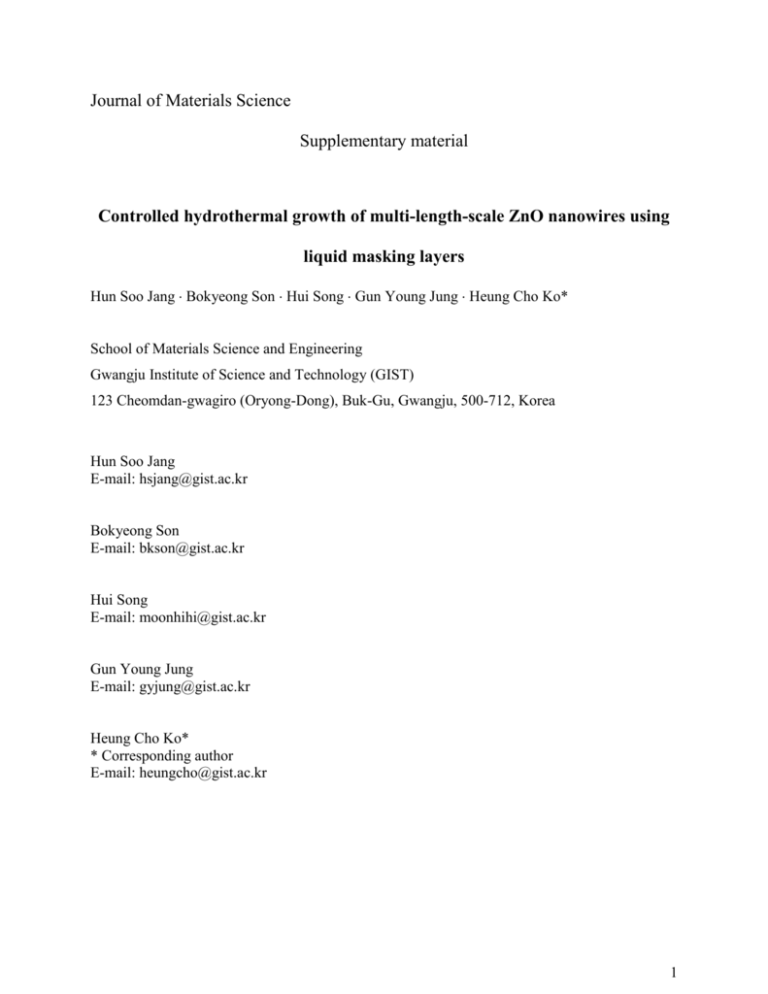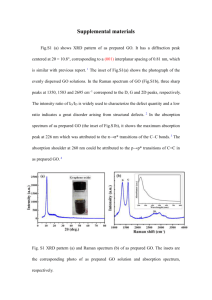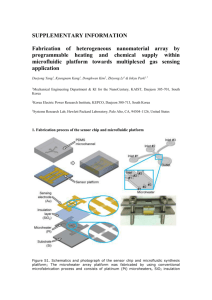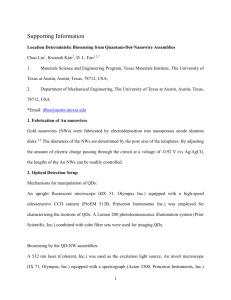Template for Electronic Submission to ACS Journals
advertisement

Journal of Materials Science Supplementary material Controlled hydrothermal growth of multi-length-scale ZnO nanowires using liquid masking layers Hun Soo Jang Bokyeong Son Hui Song Gun Young Jung Heung Cho Ko* School of Materials Science and Engineering Gwangju Institute of Science and Technology (GIST) 123 Cheomdan-gwagiro (Oryong-Dong), Buk-Gu, Gwangju, 500-712, Korea Hun Soo Jang E-mail: hsjang@gist.ac.kr Bokyeong Son E-mail: bkson@gist.ac.kr Hui Song E-mail: moonhihi@gist.ac.kr Gun Young Jung E-mail: gyjung@gist.ac.kr Heung Cho Ko* * Corresponding author E-mail: heungcho@gist.ac.kr 1 Fig. S1 X-ray diffraction patterns of ZnO nanowires prepared by hydrothermal growth using a) open vessel, b) top LML, and c) top/bottom LMLs in Fig. 2. The three patterns have dominant peaks at 34.4° corresponding to (002) plane [23,38]. The peaks at 33.0°, marked with *, are attributed to Si (100) substrate used in this measurement. 2 Fig. S2 Transmission electron microscopy (TEM) images and selected area electron diffraction patterns of the ZnO nanowires prepared by hydrothermal growth using a) open vessel, b) top LML, and c) top/bottom LMLs in Fig. 2. 3 Fig. S3 Photograph of the experimental setup for ZnO nanowire growth on a cylindrical glass in spiral-type motion mode. 4 Fig. S4 Cross-sectional SEM image of a photodetector (left) and elemental map (right) from EDX analysis of the selected region (orange dashed box). The green color corresponds to sulfur and the red color corresponds to zinc. Cohesive fracture in the layer of ZnO nanowires occurred during sample preparation for this measurement. 5 Fig. S5 Cross-sectional SEM images of ZnO nanowires of the sample in Fig. 6b in the areas of three different Cr electrode patterns. 6 Fig. S6 Cross-sectional SEM images of ZnO nanowires of the sample in Fig. 6f in the areas of zone A (a), zone B (b), and zone C (c). 7 Fig. S7 Cross-sectional SEM image and elemental profiles of carbon (C), sulfur (S), zinc (Zn), and chromium (Cr) by EDX line scanning along the surface normal of the photodetector based on Fig. 6f. The analysis of the cross-section corresponding to zone B (average length of ZnO nanowires = 1.7 μm) is shown as a representative to show significant infiltration of P3HT into the layer of the longest ZnO nanowires in Fig 6f. 8











![Self-assembled photosystem-I biophotovoltaics on nanostructured TiO[subscript 2] and ZnO Please share](http://s2.studylib.net/store/data/012549649_1-ebc6c5d4df9bd3cf2aee915c1adfdbef-300x300.png)